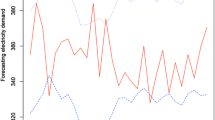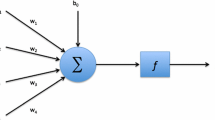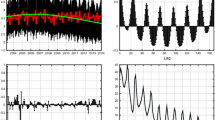Abstract
This paper considers univariate online electricity demand forecasting for lead times from a half-hour-ahead to a day-ahead. A time series of demand recorded at half-hourly intervals contains more than one seasonal pattern. A within-day seasonal cycle is apparent from the similarity of the demand profile from one day to the next, and a within-week seasonal cycle is evident when one compares the demand on the corresponding day of adjacent weeks. There is strong appeal in using a forecasting method that is able to capture both seasonalities. The multiplicative seasonal ARIMA model has been adapted for this purpose. In this paper, we adapt the Holt–Winters exponential smoothing formulation so that it can accommodate two seasonalities. We correct for residual autocorrelation using a simple autoregressive model. The forecasts produced by the new double seasonal Holt–Winters method outperform those from traditional Holt–Winters and from a well-specified multiplicative double seasonal ARIMA model.




Similar content being viewed by others
References
Taylor JW and Buizza R (2003). Using weather ensemble predictions in electricity demand forecasting. Int J Forecasting 19: 57–70.
Taylor JW and Buizza R (2002). Neural network load forecasting with weather ensemble predictions. IEEE Trans Power Syst 17: 626–632.
Bunn DW (1982). Short-term forecasting: a review of procedures in the electricity supply industry. J Opl Res Soc 33: 533–545.
Infield DG and Hill DC (1998). Optimal smoothing for trend removal in short-term electricity demand forecasting. IEEE Trans Power Syst 13: 1115–1120.
Christiaanse WR (1971). Short-term load forecasting using general exponential smoothing. IEEE Trans Power Apparatus Syst Pas 90: 900–902.
Lamedica R, Pnedenzi A, Sforra M, Caciotta M and Cencelli VO (1996). A neural network based technique for short-term forecasting of anomalous load periods. IEEE Trans Power Syst 11: 1749–1756.
Laing WD and Smith DGC (1987). A comparison of time series forecasting methods for predicting the CEGB demand. Proceedings of the Ninth Power Systems Computation Conference, Cascais, Portugal.
Darbellay GA and Slama M (2000). Forecasting the short-term demand for electricity — do neural networks stand a better chance? Int J Forecasting 16: 71–83.
Hippert HS, Pedreira CE and Souza RC (2001). Neural networks for short-term load forecasting: a review and evaluation. IEEE Trans Power Syst 16: 44–55.
Box GEP, Jenkins GM and Reinsel GC (1994). Time Series Analysis: Forecasting and Control, 3rd edn, Prentice-Hall: Englewod Cliffs, NJ, p 333.
Makridakis S, Chatfield C, Hibor M, Lawrence M, Mills T Ord K and Simmon LF (1993). The M2-competition: a real-time judgementally based forecasting study. Int J Forecasting 9: 5–22.
Winters PR (1960). Forecasting sales by exponentially weighted moving averages. Mngt Sci 6: 324–342.
McKenzie E (1976). A comparison of some standard seasonal forecasting systems. The Statistician 25: 3–14.
Abraham B and Ledolter J (1986). Forecast functions implied by autoregressive integrated moving average and other related forecast procedures. Int Stat Rev 54: 51–66.
Hyndman RJ, Koehler AB, Snyder RD and Grose S (2002). A state space framework for automatic forecasting using exponential smoothing methods. Int J Forecasting 18: 439–454.
Taylor JW (2003). Damped multiplicative trend exponential smoothing. Int J Forecasting, forthcoming.
Williams DW and Miller D (1999). Level-adjusted exponential smoothing for modeling planned discontinuities. Int J Forecasting 15: 273–289.
Smith DGC (1989). Combination of forecasts in electricity demand prediction. J Forecasting 8: 349–356.
Gardner ES Jr. (1985). Exponential smoothing: The state of the art. J Forecasting 4: 1–28.
Reid DJ (1975). A review of short-term projection techniques. In: Gordon HA (ed). Practical Aspects of Forecasting. Operational Research Society: London, pp 8–25.
Gilchrist W (1976). Statistical Forecasting. Wiley: Chichester.
Chatfield C (1978). The Holt–Winters forecasting procedure. Appl Stat 27: 264–279.
Chatfield C (1985). Comments on ‘Exponential smoothing: the state of the art’ by Gardner ES Jr. J Forecasting 4: 30.
Chatfield C and Yar M (1988). Holt–Winters forecasting: some practical issues. The Statistician 37: 129–140.
Taylor JW and Majithia S (2000). Using combined forecasts with changing weights for electricity demand profiling. J Opl Res Soc 51: 72–82.
Acknowledgements
We are grateful to Shanti Majithia, Chris Rogers, and Sal Sabbagh of National Grid for supplying data and information regarding the company's online demand forecasting. We are also grateful for the useful comments of the anonymous referees.
Author information
Authors and Affiliations
Corresponding author
Rights and permissions
About this article
Cite this article
Taylor, J. Short-term electricity demand forecasting using double seasonal exponential smoothing. J Oper Res Soc 54, 799–805 (2003). https://doi.org/10.1057/palgrave.jors.2601589
Received:
Accepted:
Published:
Issue Date:
DOI: https://doi.org/10.1057/palgrave.jors.2601589




